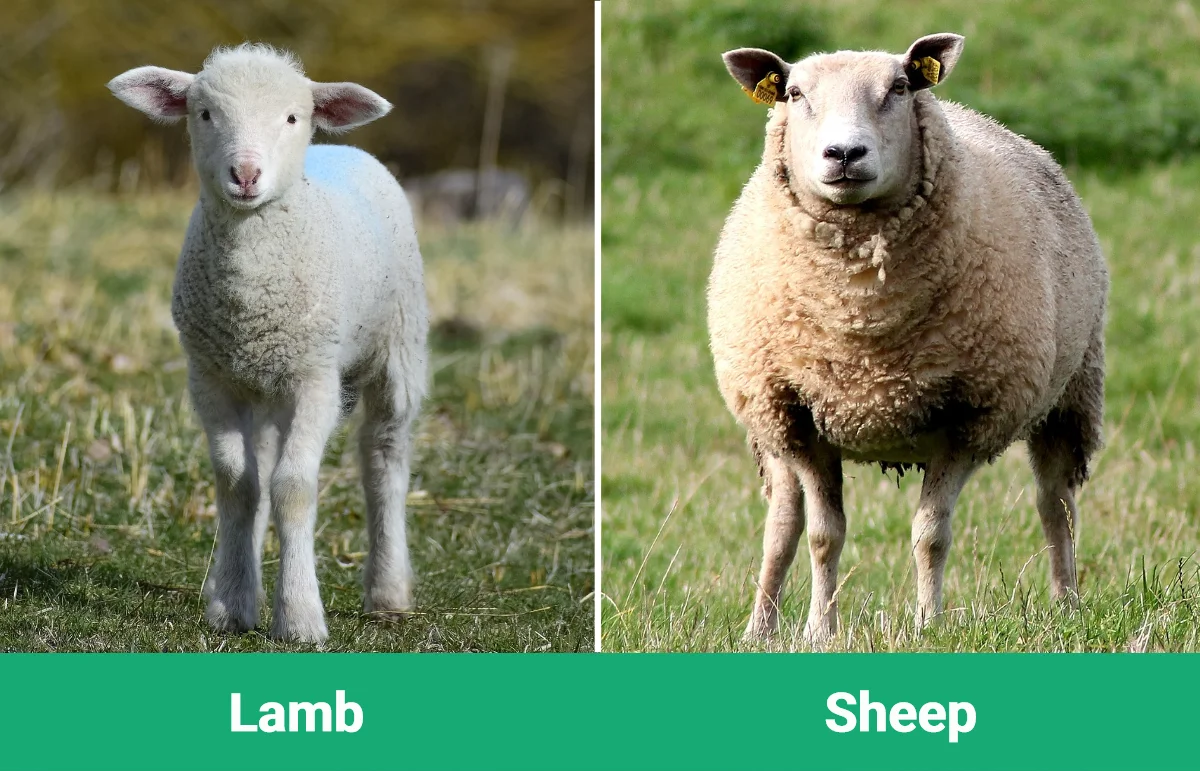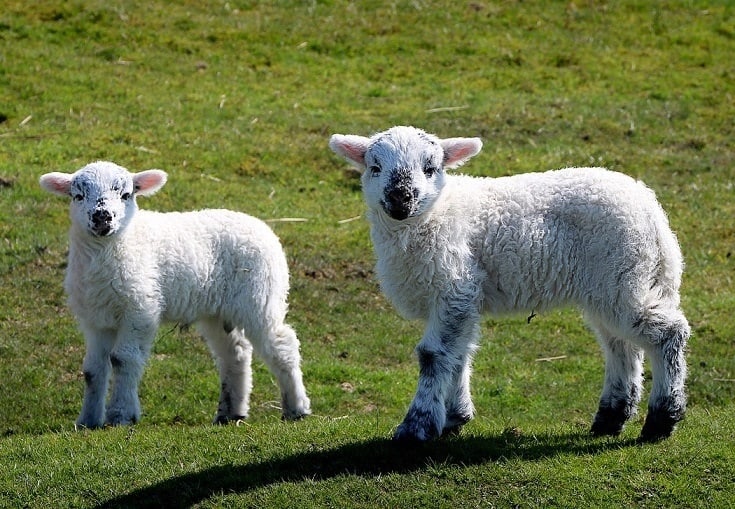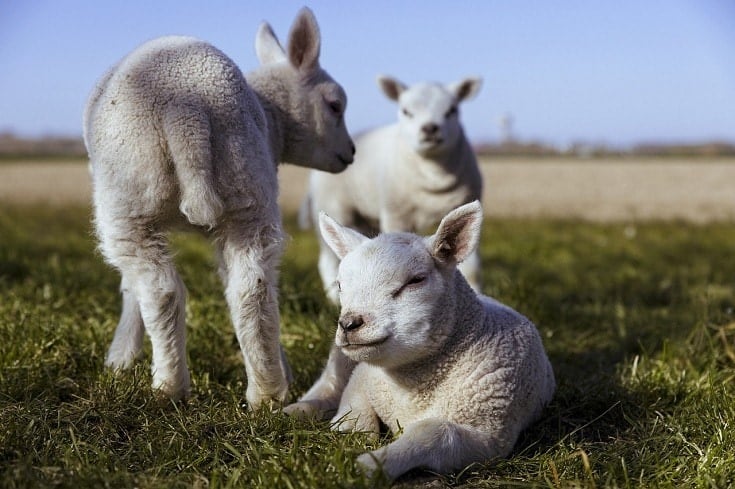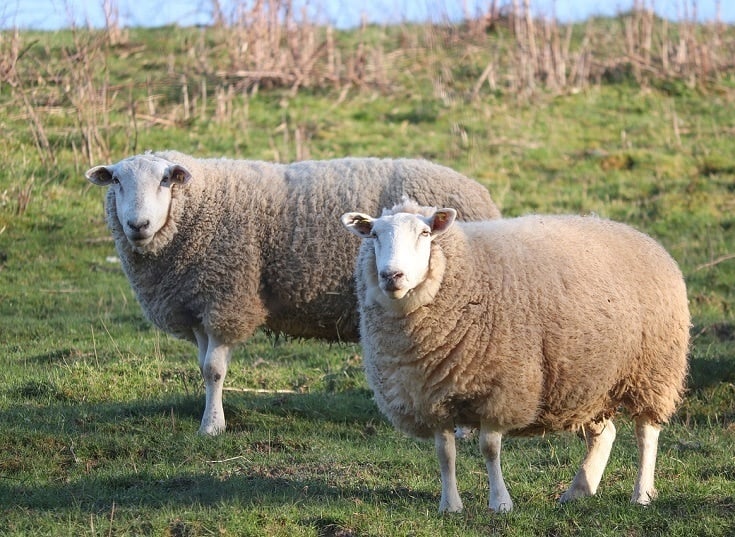Are sheep and lamb the same? A lamb is a young sheep, aged under 12 months, whereas a sheep can be of any age and any gender. The difference is especially important when selling because lambs normally have greater value than older sheep.
Lamb’s meat is leaner and has a milder flavor. Mutton, which is the meat of older sheep, has a darker color, more intense flavor, and usually has more fat than lamb’s meat. Lamb leather is also preferred over sheep’s leather, while lamb’s wool is considered softer than sheep’s wool. Finally, lambs are easier to tend than sheep, because they are gentle and can be handled.
The preference for lamb meat and hides, as well as the fact that a sheep can never revert to become a lamb, makes them more expensive and more appealing.

Visual Differences

At a Glance
- Average weight (adult): 80–120 pounds
- Age: <12 months
- Diet: Milk, herbivore
- Care needs: Moderate
- Family-friendly: Yes
- Other pet-friendly: Usually
- Trainability: House training rarely possible
- Average weight (adult): 200–350 pounds
- Age: 10–12 years
- Diet: Herbivore
- Care needs: Minimal
- Family-friendly: Rams may be aggressive
- Other pet-friendly: Yes
- Trainability: Followers

Lamb Overview

The lamb is any sheep, regardless of gender, under the age of 12 months. Once the animal reaches 12 months, it is no longer considered a lamb. Lamb meat, wool, and hides are usually considered superior to that of adult sheep, but once you slaughter or sell a lamb, it’s gone. By keeping it until it becomes a sheep, you may get diminishing returns on the hides and wool, but you will be able to claim this for the 10 to 12 years that the adult sheep lives.
Personality / Character
Lambs are considered friendly and gentle animals. They can be playful and will even form a bond with their human owners, especially if they are bottle-fed. Bottle feeding a lamb convinces it that you are its mother. The animal will usually get along with other sheep, lambs, animals, and people. They are sometimes kept as pets because they are gentle and friendly and because they are sometimes viewed as being little comedians that like to make people laugh.
Training
It is possible, but very rare, that a lamb can be properly house trained. Generally, though, they will pee and poo whenever and wherever they need to, which includes indoors at any time. If you will be keeping a lamb indoors, it is suggested that they wear a nappy and you cut a hole out for their tail. You can buy larger nappies as your lamb ages.
Health & Care
There are different breeds of lamb available, and the actual care that is required will depend on the breed. Some may require regular sheering for example, while others will shed their coat and not need any sheering whatsoever. If you have a male and plan to keep it as a pet, it will need to be neutered as soon as possible, otherwise, it can grow aggressive and difficult to live with.
If you do intend to keep the lamb as a pet, it is recommended that you have annual vaccinations and have it regularly dewormed. Finally, you will also need to clip your lamb’s hooves, but this is best left to a professional unless you have experience already. If you get it wrong, you can cause serious discomfort to your lamb.

Diet and Nutrition
Your lamb will need bottle-feeding when young, and this requires replacement milk specifically made for lambs. They require grass to graze on, and they prefer coarse grass. A local feed store should stock this and, if you are struggling, there are online stores that will sell the feed and deliver it to your home. Use grain supplements to ensure that your lamb is getting all the nutrients it requires.
Suitable For:
Lambs can make good pets, but there are some potential pitfalls that you will need to overcome. The greatest downside of keeping a lamb as a pet is that it can rarely be housetrained. This means that your lamb will have to wear nappies while indoors. Lambs are also kept as livestock, although it is worth noting that you are unlikely to make money from lamb’s wool or hides unless you have an artisanal quality show breed.

Sheep Overview

A sheep is an adult sheep over 12 months. Before this, they are known as lambs, regardless of their gender. However, once a lamb reaches 12 months, it graduates to becoming a sheep and is called a ewe if it is female, or a ram if it is male. Rams and ewes can have very different temperaments, but both are kept as livestock around the world, and are particularly popular for their wool and for their meat, although lamb meat is more popular than mutton, which is the name given to the meat of older sheep. It is very rare to keep sheep as pets, especially indoor pets.
Personality / Character
Sheep were first domesticated in 5,000 BCE. Their remains have been found in various sites across the Middle East, Europe, and Central Asia. They are bred and raised for their meat, wool, and their milk. There are believed to be approximately one billion sheep in the world. They are prevalent in countries and areas where there is substantial grassland, and there are hundreds of different breeds and hybrids, each with its own characteristics and traits.
The sheep is a meek animal. It will usually follow one leader, whether this is a sheep or a person. This tendency makes them easy to keep as livestock because it means that controlling a dominant sheep elicits control over the total flock.
Keeping Sheep
Sheep are considered excellent livestock for small homesteads, as well as for large farms. They are considered easy to care for and can bring in a regular income. Expect to keep between 6 and 10 sheep on each acre of grass. If breeding for wool, ensure that you choose a breed that is known for its high-quality fleece. In fact, even if your main aim is meat or milk, fleece is basically a renewable resource that can bring in a secondary and additional income so is worth bearing in mind.
- You may also like: Sheep vs. Goat: What’s the Difference? (With Pictures)
Health & Care
Preventing disease not only improves the economic performance of your flock, but it improves the general wellbeing and health of your animals. Common illnesses include blackleg, botulism, and tetanus. You should ensure that your flock gets the appropriate inoculations to properly protect them, monitor every sheep, and seek veterinary assistance if any look ill. Some diseases can spread rapidly between members of the flock, causing devastation.
- Related Read: What Do Sheep Eat In the Wild and as Pets?

Suitable For:
Sheep are considered easy to care for and rear. They will continue to produce fleeces and milk throughout most of their adult life, and by carefully selecting the right breed of sheep, you could turn a decent second or even primary income. They are not suitable as pets but are suitable for keeping on homesteads and for farming.

Which Breed Is Right for You?
Sheep are four-legged ruminants that have been domesticated and are commonly reared and farmed for their meat, milk, and fleece. They can deliver a profit and offer an income to the farmer, and even a small number of sheep can keep a homesteader comfortable. Lambs are young sheep that are less than 12 months, and they can be either sex. Lambs can be kept as pets, but are rarely house trained, and they will usually live a better life with the company of other sheep. They are funny, sweet, and cute little animals, though, that will get along with virtually anybody and any animal.
You may want to read next:
Featured Image Credit: Top – Ben_Kerckx, Pixabay | Bottom – Luke Stackpoole, Unsplash
